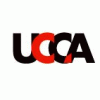 |
Ullens Center for Contemporary Art
798 Art District, No.4 Jiuxianqiao Lu, P.O. Box 8503,
Chaoyang District,
Beijing, P.R.China, 100015 map *
tel: +86 10 8459 9269
fax: +86 10 8459 9717
send email
website
|

Enlarge
|
| Golden Sky
|
|
| by Ullens Center for Contemporary Art
Location: UCCA Middle Room
Artist(s): YU Hong
Date: 17 Jul - 15 Sep 2010
In her new series Golden Sky , acclaimed painter Yu Hong reanimates history by combining classical and religious composition with scenes from modern, secular life. Inspired by the Buddhist cave paintings of Dunhuang and Kizil, classical western works of art and her own extensive reading and scholarship, the artist populates her large canvases with vivid, life-sized figures that are as familiar to us as we are to them: men, women and children going about their daily lives against the backdrop of a golden sky, citizens of a gilded and uncertain age.
In art as in life, a slight shift in perspective can lead to a greatly altered perception. Displaying Yu Hong's paintings on the ceiling reinvigorates the relationship between viewer and viewed, subject and object, artist and audience. As we gaze up at the people in Yu Hong's paintings and they gaze back at us, one thing seems clear: all of us are looking at a present that will someday be history.
- Jérôme Sans, UCCA Director
Yu Hong: Reconstructing and Reinterpreting the Classics
When a work of art becomes a classic or is transformed into a symbol , i ts meaning is fixed. Later, as the work is reconstructed and reinterpreted, it takes on a broader moral and intellectual significance. The process by which this happens is not unlike a complex mathematical equation, where the present value of certain variables determines the work's future importance.
Atrium, Questions for Heaven, Natural Selection and Sky Curtain take their cues from classical, highly-symbolic works of art. By stripping away the original religious, historical or mythological variables and replacing them with people and scenes from the present day, Yu Hong translates the classical language of painting into a modern vernacular.
In Golden Sky, the artist's canvases are displayed on the ceiling, thus allowing us to engage with her work on a deeper level. It is akin to a religious experience:we marvel at her paintings not just for their beauty and majesty, but for the epiphanies they inspire.
- Zheng Yan, Head of Art Department
ARTIST STATEMENT
For the last several years, I've been very focused on classical Chinese and western culture. Bycombining research into traditional culture with a re-examination of contemporary society, I hope to create works of art that transcend cultural barriers and capture the essence of something universal.
Atrium was inspired by Trionfo di Ercole (Triumph of Hercules) from the Quattro Stagione del'Olimpio (Four Seasons of Olympia) fresco at the Palazzo Pepoli Campo Grande in Bologna, Italy, but the subjects are people I've taken casual snapshots of. They're all going about their lives, playing and talking and reaching out for things unseen. It's just like in real life: none of us can see everything, or escape our own blind spots.
Questions for Heaven takes its composition from a Buddhist cave painting from Dunhuang's Mogao Grottoes, and its title from a two-thousand-year old poem that poses 172 questions about the universe. It expresses the uncertainty people feel in our fast-paced society, the doubts and unanswered questions we have about the world, life, ethics, morality, and economic and social development.
Natural Selection is modeled on Ridiculous Folly , a copperplate etching by Francisco Goya. It explores the relationship between human beings and the civilization we create. If through our own greed and folly, we lose the civilization we've made, we'll end up right back where we started and our lives will be duller than ever.
Sky Curtain relates to a cave painting that once adorned the grottoes in Kizil, Xinjiang Province. To that composi t ion, I added elements of contemporary news photos to illustrate the cycle of humanity – birth and death, ignorance and wisdom, loss and gain – and force the viewer to confront the unavoidable realities of life. These four paintings will be displayed on the ceiling of the Middle Room at UCCA. I hope the effect will be like classical ceiling frescoes: viewers will raise their heads to look up at them, and the subjects in the paintings will gaze back down. |
|
|
|
|
